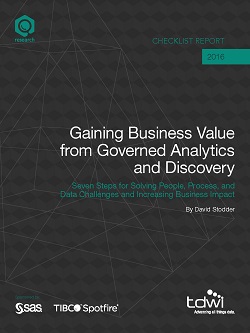
TDWI Checklist Report | Gaining Business Value from Governed Analytics and Discovery
June 1, 2016
Strong interest in easier-to-use, self-service tools is democratizing BI, analytics, and data discovery. The tools are spreading by popular demand, often beginning in LOBs and business departments outside of IT control. This has led to tension between IT and business users over data access, data ownership, and the development and execution of analytics models. Some of the friction is about politics, but many IT concerns are valid—democratization of BI and analytics has the potential to introduce data chaos. In organizations that do not have centralized IT, users moving from spreadsheets to more powerful visual analytics and discovery tools can become frustrated when they encounter the “chaos” of poor data quality, particularly when trying to share analyses with colleagues.
These issues make it imperative for organizations that seek democratized visual analytics and discovery to improve governance. Several things make up good governance. First, governance is about
giving the right users access to the right data while ensuring sensitive data is protected. Data preparation and hygiene are also key, particularly for improving and safeguarding data quality.
Governance is also about promoting efficiency, consistency, and reuse of analytics models and processes, including the management of champion models.
Finally, governance must oversee the content produced by end users, such as dashboards and visualizations, to ensure they adhere to standards and reduce—rather than spread—data chaos.